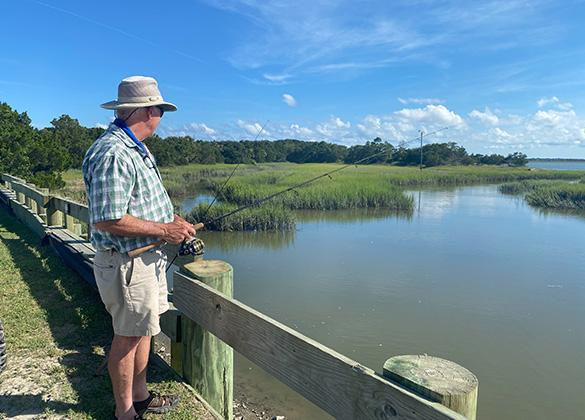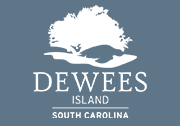Fishing on Dewees

Behind Dewees Island sits Copahee Sound, and every day literally billions of gallons of seawater ebb and flow into this bay structure. Along with fish, and crabs, and all the animals that exist because of the marine life. Inshore and offshore fishing charters are available year-round, offering every type of fish, from wahoo to spot tails.
Fishing Etiquette
Obey all state laws regarding size and amount limits. These rules are posted on various docks around the island.
Practice the Dewees philosophy of catch and release. If you are fishing for food, take from the sea enough for an evening’s meal. This ensures plenty of fish to catch in the future and always the freshest, best tasting fish for supper! If you have a large houseful of visitors please be considerate of other families and supplement your interior-island catch from exterior waterway.
If an alligator is sighted within 60 feet of your fishing activities please immediately remove your lines and relocate to another location.
Catch & Release tips:
Keep the fish in the water as much as possible. If possible, remove the hook without removing the fish from the water.
Always handle a fish with wet hands.
Use non-offset circle hooks.
Snip deeply embedded hooks and allow them to dissolve. Cut the line if the fish is hooked in the throat or stomach. Fish are much more likely to survive if deeply embedded hooks are left in place and allowed to dissolve.
If the hook is in the jaw or lip, hold the fish gently at the base of the head just behind the gill covers and remove the hook with needle nose pliers. Be very careful not to squeeze the fish.
Don't drop the fish in the boat or allow it to thrash around on the shore. Fish bruise easily, and damage to internal organs can be fatal.
Never lift fish by the eye sockets or gills. Use both hands to support the fish's weight evenly.
When you catch the monster, he will be quite exhausted after a long fight. He can be revived by holding it upright in the water and gently moving it back and forth.
Fishing licenses can be purchased online at:
Weekly Fishing Reports for South Carolina Waters:
Local Vendors of Tackle, Bait, and Fishing Licenses
Crabbing
Crabbing is a fun thing to do when you are looking for dinner. Here are some strategies for successfully catching crabs while keeping the population sustainable and allowing neighbors a chance to catch crabs too.
Share the dock. The most popular place to crab is at the dock near the rice trunk. It is considered good etiquette to limit your crabbing to an hour or so, rather than monopolize the dock. (Carts that drive by repeatedly are likely neighbors waiting for a turn and too polite to say so.)
Measure and check the gender. It is illegal to keep crabs smaller than 5 inches wide and females with egg "sponges". The black sign on the dock is the right length to use as a measuring stick. Learn to tell the difference between male and female crabs. Return female crabs with sponges to the water.
Keep crabs in a dry, shaded bucket. Crabs should NOT be kept in water or ice water, because they will deplete the available oxygen and drown. Rather, keep them in a dry shaded bucket until you are ready to cook them. If it is very hot, you can place an ice pack in the bucket or use a double bucket system with ice in the bottom.
Use only a crab line and hand net in the impoundment. Crab traps may be used on the outside of the island, provided they are labeled with the owner’s name and equipped with terrapin extruder devices.
Take only what your family can eat in one meal. This helps us preserve the balance of the ecosystem, and is courteous to your fellow crabbers. If you are single-handedly feeding a crowd of 25, you should probably shop for seafood in Mount Pleasant or on the Isle of Palms.
Use mullet or fish heads to bait lines with, NOT chicken, which will attract alligators.
Use the provided bucket. When casting for bait do not throw dead or dying bycatch into the impoundment. Instead, put it and any leftover bait, dead fish, shrimp heads, etc. in this bucket. When you are done for the day, take the bucket across the road and dump it on the outside of the impoundment.
Return the bucket to its original spot so the next crabbers can use it, making sure to secure the line over the post.
You do not need a Saltwater Recreational Fishing License for crabbing with no more than two lines per person at the crabbing dock.
Know the alligator safety rules.
Casting for Shrimp and Bait
The silhouette of a cast net flying across the water is a classic icon of the lowcountry. Both for catching bait and harvesting shrimp for dinner, casting can be a fun activity for all ages.
Know the rules. You can't keep most large fish (flounder, etc. ) caught in a cast net. If you have questions, check the SCDNR website.
Share the dock. It is considered good etiquette to limit your casting to an hour or so, rather than monopolize the dock. (Carts that drive by repeatedly are likely neighbors waiting for a turn and too polite to say so.)
Take only what your family can eat in one meal. This helps us preserve the balance of the ecosystem, and is courteous to your fellow anglers. If you are single-handedly feeding a crowd of 25, you should probably shop for seafood in Mount Pleasant or on the Isle of Palms. Do not stock a freezer or cooler with shrimp for another day.
Be careful with bycatch. There is a bucket system in place on the dock to provide you with a way to release what you've caught that you don't want. Do not throw dead or dying bycatch into the impoundment. Instead, put it and any leftover bait, dead fish, shrimp heads, etc. in this bucket. When you are done for the day, take the bucket across the road and dump it on the outside of the impoundment.
Leave the dock when an alligator comes within the white markers.
Watch out for obstacles. The rice trunk has ensnared many a net. If your net does get caught on something and you can't release it, call Lori or the interns for help.
Alligator Safety Rules for fishing and crabbing
Only crab with weighted hand lines in the impoundment. Do not use crab traps, or leave crab traps at the crab dock. Crabs feed on the bottom and alligators feed at the surface, so use a weighted line and always keep bait on the bottom. Bait on the surface will attract alligators.
Only use fish as crab bait. Use fish or shrimp heads, or catch mullet in a cast net. Bait can be purchased at the marina store. Do not use chicken or other meat. (Alligators investigate the unusual smell.)
Use the bucket on the dock to dispose of dead or dying bycatch, shrimp heads, or anything else you catch in your cast net that you don't want. Carry it to the outside of the impoundment and dump it there. Return the bucket to the dock.
Minnow and crab traps are best placed on the outside of the island. Since thrashing fish and captive bait can be irresistable to alligators, do not hang minnow traps or keepers off the crabbing dock.
Leave the dock if an alligator is paying close attention to your fishing efforts. If they come to associate people with food, everyone is at risk. If you are fishing and crabbing and an alligator comes within 60 feet of you, immediately remove all lines from the water and leave the area. (If you are at the crabbing dock, the white pipes delineate the 50'.)
Keep your pet on leash or voice control at all times.
Contact public safety at 843-296-4952 , or the Environmental Program Director at 843-568-3994 if you are alarmed or concerned that an alligator is behaving unduly aggressively.
Check to see if the dock is closed to hook and line fishing. The main crabbing dock is closed to line fishing during the summer, so we don't attract alligators. Signs are posted at the dock.
A fed gator is a dead gator. It is crucial that alligators not become overly accustomed to humans, or begin to associate humans with food. When alligators lose their fear of humans, we have to close the dock or kill the alligator. Since Dewees is a conservation easement, we are not regularly permitted to remove and kill an alligator. Each one of us is an important part of the process. If we want to preserve our favorite crabbing and fishing areas, they must be safe for alligators, too.
Shellfish
If you haven't been to an oyster roast, put it on your bucket list. Shellfish abounds in the area, and the oysters are salty and large. Don't forget to try the fish stew when you go. It is a local specialty served at most oyster roasts.
You can shellfish for you own meal too! The season typically runs October 1 to May 15. It is illegal to harvest shellfish between ½ hour after official sunset and ½ hour before official sunrise. To harvest any shellfish in the waters of South Carolina, including oysters, hard clams, and mussels, you must have a recreational saltwater fishing license and abide by DNR size and quantity regulations.
- Clams must be 1-inch thick
- The shells of oysters harvested on Dewees can be recycled to the island shellfish beds
- Please refer to the DNR’s website for a full run-through of shellfish harvesting guidelines.
Getting a license
In the winter, shell fishing can be a great way to catch a quick meal in the wintertime. We have clams, oysters, and mussels on Dewees.
You do need a valid SC Saltwater recreational fishing license. Check the SCDNR website for current limits and a great video on how to select and harvest oysters.
Know where the private oyster beds are: you can't harvest if the bed is leased to a commercial harvester.
Check the season. Oysters and Clams are typically closed from May 16 to September 30, depending on conditions. Call 843-953-9300 for season dates. It is illegal to harvest shellfish between 1/2 hour after official sunset and 1/2 hour before official sunrise.
Protect your hands and feet. Boots and gloves are helpful for oysters and keeping yourself safe from the sharp shells.
Watch the tide. It can come in quickly and strand you on small islands.
Return shells to the water on the outside of the impoundment. Oysters use old shells to grow on, so returning oyster shells to the water helps ensure future harvests.
Maps of shellfish beds are at dnr.sc.gov/marine/shellfish/shellfishmaps.html
Limits:
- A person may recreationally harvest shellfish (oysters and/or clams) no more than 2 days per 7 day period.
- Oysters: 2 U.S. bushels per person per day from public or state shellfish grounds; No boat, vehicle, or boat/vehicle combination may contain more then 3 personal limits regardless of the number of people on the boat or in the vehicle.
- Clams: Size minimum = 1 inch. 1/2 U.S. bushel per person per day from public or state shellfish grounds; No boat, vehicle, or boat/ vehicle combination may contain more than 3 personal limits regardless of the number of people on the boat or in the vehicle.
For more information, contact:
[email protected] or 843-568-3994





